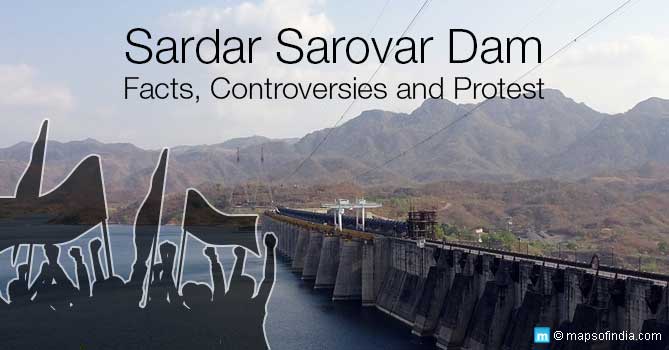After an incubation period that runs into several decades, the Prime Minister of India Narendra Modi finally inaugurated the Sardar Sarovar Dam – a project that has earned the moniker “Lifeline of Gujarat”. The foundation stone of this dam – the largest gravity dams in the country – had been laid by India’s first Prime Minister, Pt. Jawaharlal Nehru, in 1961 but it was finally on Sunday, 17 September, 2017 that PM Modi (on his 67th birthday) inaugurated this dam. The Sardar Sarovar Dam is also the second largest concrete dam in the world. It shall usher in an era of development for Gujarat, Madhya Pradesh, Maharashtra, and Rajasthan claims the government.
The Dream
The construction of the Sardar Sarovar dam across the Narmada was the brainchild of Sardar Vallabhbhai Patel – India’s first Deputy PM. This ambitious project ran into a dispute regarding the distribution of waters among the states, even at the planning stage. In 1969, the Narmada Water Dispute Tribunal was constituted to overcome this hurdle and to take it forward. After about a decade of studying the plans, the reports from the states, and the petitions of all those concerned, the court decided on a system of water distribution that would award Madhya Pradesh about 65 percent, Gujarat some 32 percent, and the remaining to Maharashtra and Rajasthan. The tribunal also laid out conditions for resettlement of those who had been displaced and also asked for an increase in the dam’s height. It looked that the 1980s would bring a successful culmination to this ambitious project but there was much more in store.
Narmada Bachao Aandolan
The mid 1980s saw the rise of one of India’s best known and most persistent activist – Medha Patkar. Since the first time she visited the dam site in 1985, Ms. Patkar and her associates have been engaged in large scale protests against the construction and inauguration of the Sardar Sarovar Dam. The main complaint of the protest who came to form the Narmada Bachao Aandolan is that the thousands of tribal people who would be displaced by the construction of the dam had neither been informed of the full implications nor been compensated adequately. Medha and others realized that the World Bank had agreed to finance the project despite the refusal of the Environment Ministry to give it the ‘go-ahead’ nod. Medha and the others have, over the years, garnered support from celebrities including Baba Amte, Aamir Khan, and Arundhati Roy and her brand of activism attracted international attention. While the protestors were at times successful in stalling progress and causing extreme delays, the project has now finally been completed.
Ushering In An Era of Development
The government of India has been persistent in its effort to build the Sardar Sarovar dam siting the immense benefits it is likely to bring Madhya Pradesh, Gujarat and to the neighbouring states of Rajasthan and Maharashtra. Let us take a look at the benefits this dam is likely to bring –
- The dam is 1.2 kilometres long and the height has recently been raised to 138.68 metres. This means that the dam is now capable of storing 4.73 million acre feet of water.
- 8,00,000 hectares of land in Gujarat and 2,46,000 hectares of land in Rajasthan will be irrigated by the dam waters. It will also provide drinking water to 131 towns and cities and 9,633 villages in the four states.
- The Sardar Sarovar Dam has a depth of about 163 metres and has two power generation units installed. These, together have a power generation capacity of 1,450 MW. As of now, the two houses have together produced 4,141 crore units of electricity.
- According to the terms of the project, Maharashtra is to get 57 percent of the electricity produced, Madhya Pradesh will get 27 percent, and 16 percent will go to Gujarat.
Continuing Protests
Despite the inauguration of the dam, Medha Patkar and other activists have refused to back down from their “Jal Satyagraha”. The activists claim that 40,000 families, whose homes will now be drowned, have not been compensated. The Prime Minister, however, claimed that the inauguration occurred despite many conspiracies to prevent it.
The development and benefits that the construction and inauguration of this dam will bring to the people of northern and central India will become apparent in the years to come. In the meantime let us hope that the government takes adequate action to resettle the thousands of tribal people who have lost their homes and sacrificed their lands for such a development.





